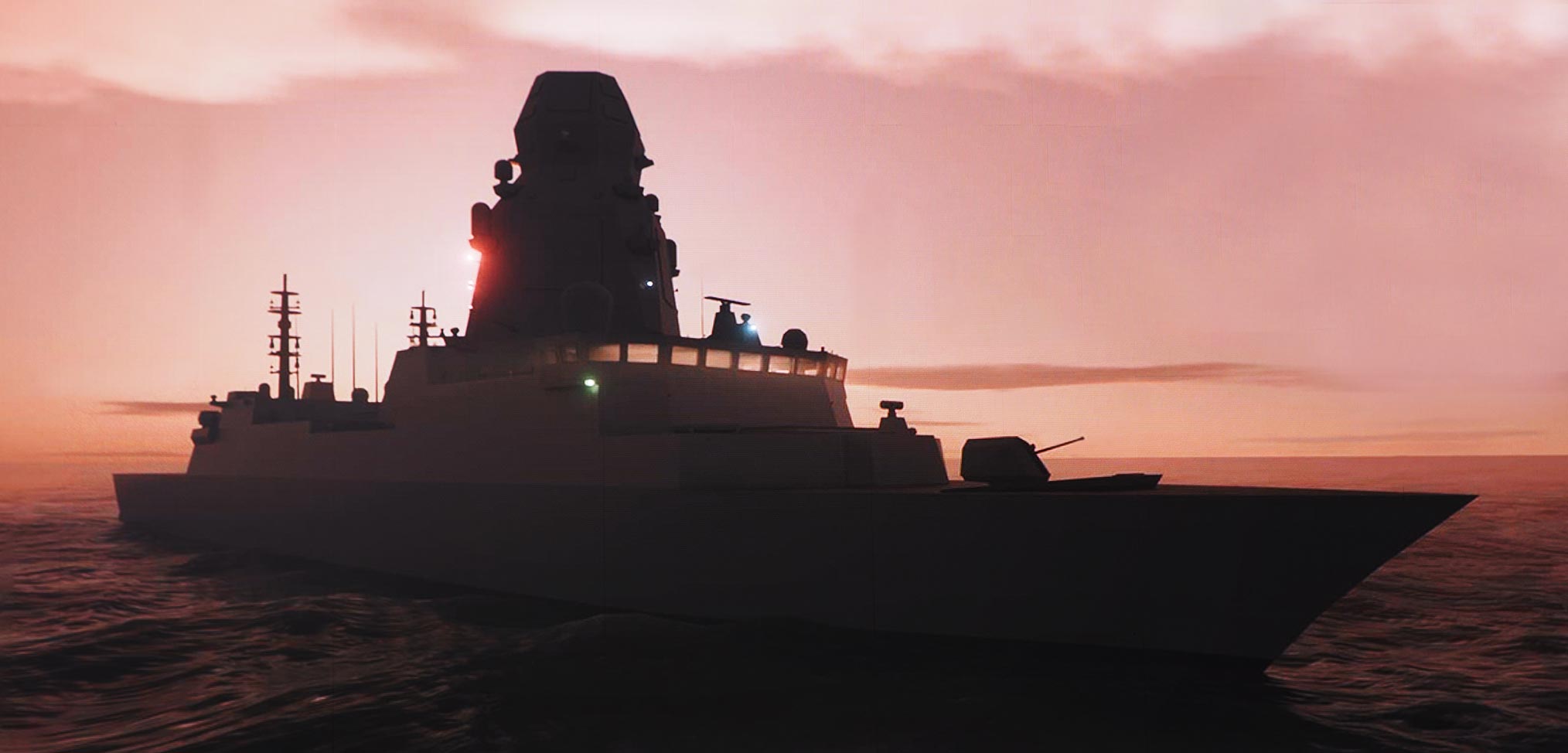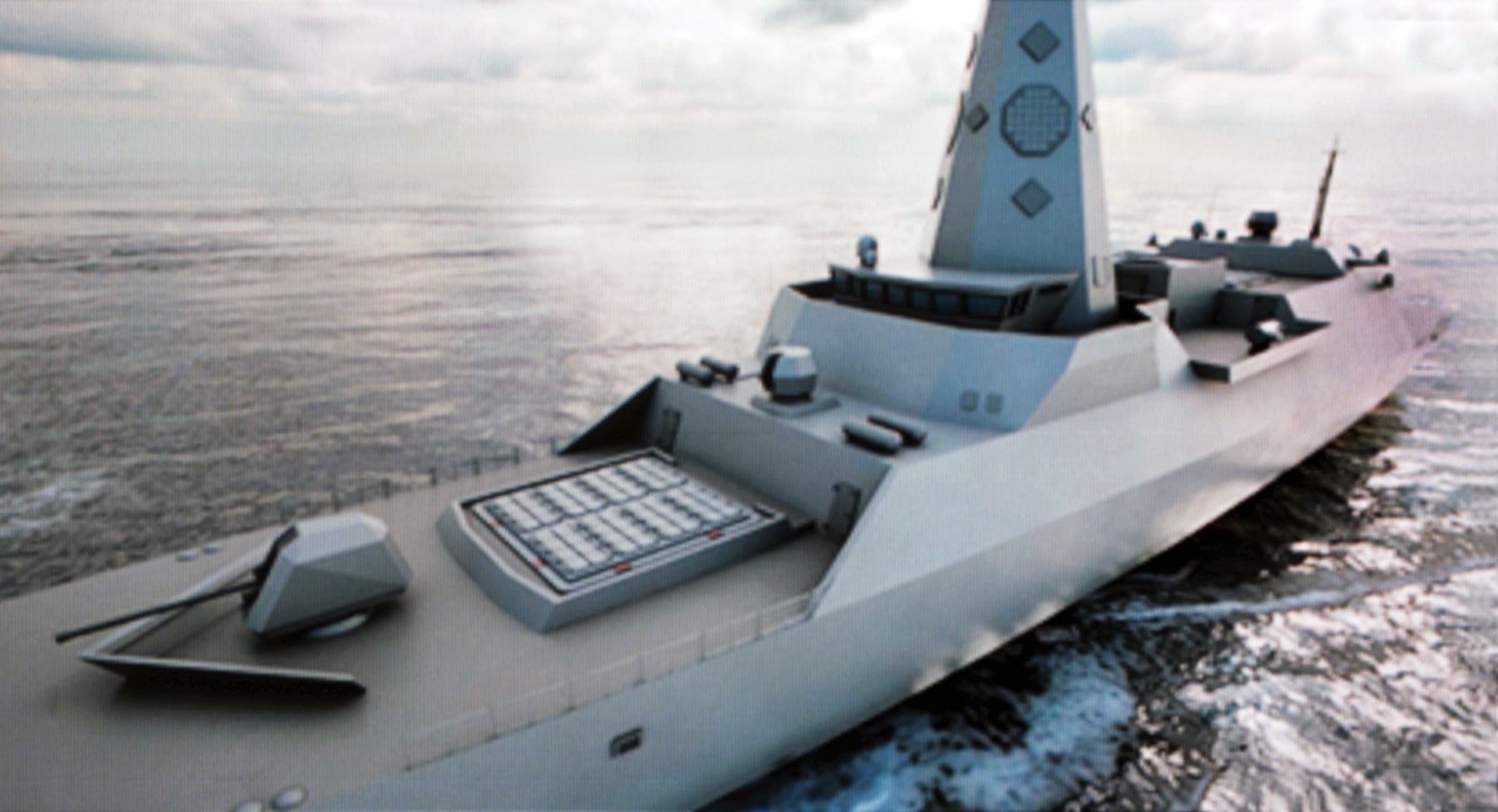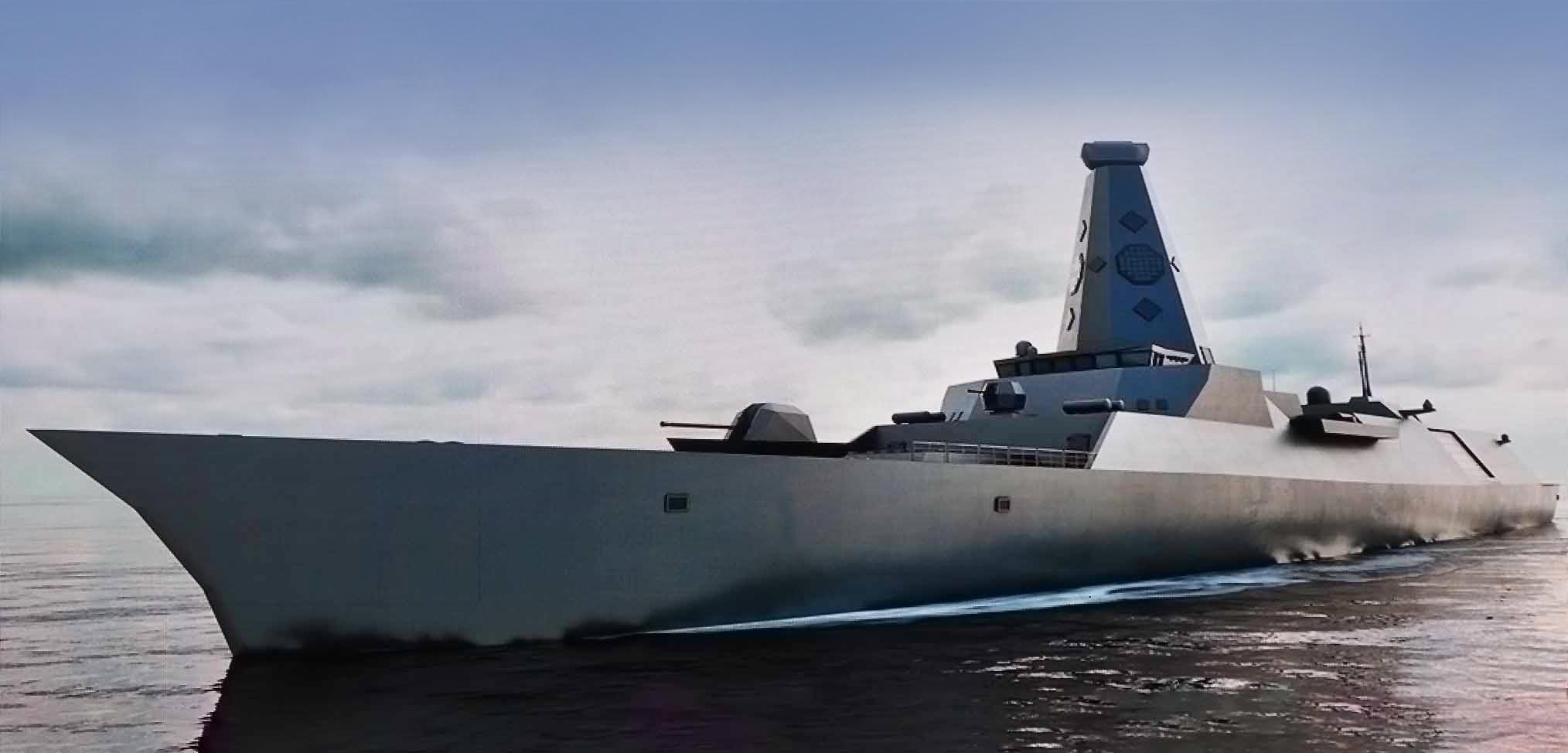The Future Air Dominance System (FADS) will define the UK’s maritime Integrated Air and Missile Defence (IAMD) and Long-Range Precision Strike (LRPS) capability from the late 2030s. Here we look at the latest thinking on this programme and at the Type 83 destroyer, which will be at the heart of this system.
The FADS portfolio
FADS is described by its Senior Responsible Owner as a ‘mega-programme’, a portfolio of interlinked projects rather than a single platform development. It responds to a strategic shift from nuclear to conventional missile threats that now dominate global conflict zones, as seen in the Red Sea, Gulf, Israel, and Ukraine. The rapid development of hypersonic and ballistic systems, together with uncrewed systems deployed in mass, has driven the need for a fundamentally new approach. LRPS will enable the elimination of ‘archer’, rather than just intercepting ‘arrows’, which is a limitation of the contemporary Type 45. The FC/ASW missile, supposedly due in service by 2028, is likely to be the main effector and also offers heavyweight anti-shipping capability.
FADS will move beyond individual platforms operating in isolation. It will utilise a Systems of Systems Approach (SOSA), designed for the machine speed of modern warfare, where legacy approaches that rely on standalone platforms are no longer viable. It will incorporate joint and allied assets from the outset and integrated across all domains. In the RN context this will include much greater fusion of sensor data from other ships, aircraft and satellites, a modern version of Cooperative Engagement Capability, with the ability to cue weapon launches from Type 26, Type 31 frigates and other platforms. More radically, consideration is being given to fitting VLS cells to the MRSS or auxiliaries to add more distributed mass. The ‘arsenal ship’ is another concept that has been around for a while but the FADS programme has now embodied this in an aspiration for the ‘Type 91 missile barge’.
Maritime-IMADS in the form of FADS will be the primary air defence shield of the UK Carrier Strike Group and whatever Littoral Strike capability the RN manages to field in future. More broadly, FADS is intended to play a part in the wider air defence of the UK and the European mainland.
 BAE Systems’ latest Type 83 imagery. Despite earlier claims that Type 26 was not suitable as the basis for the destroyer requirement, the company now says it is developing its ‘Future Air Warfare Command Ship’ concept that will have considerable commonality with Type 26. BAE Systems are almost certain to be the primary design and build contractor for the Type 83.
BAE Systems’ latest Type 83 imagery. Despite earlier claims that Type 26 was not suitable as the basis for the destroyer requirement, the company now says it is developing its ‘Future Air Warfare Command Ship’ concept that will have considerable commonality with Type 26. BAE Systems are almost certain to be the primary design and build contractor for the Type 83.
Progress to date
Like so much in defence, at the time of writing FADS is in limbo, awaiting the much-delayed SDR and subsequent Command Paper that will be the arbiter of the funding envelope. The RN describes FADS as its “highest priority future capability” and accepts it will be one of the most impactful industrial programmes of the next decade. This implies it is seen as more important than the MRSS programme, although in reality it will be secondary to Dreadnought and SSN-AUKUS. The programme is currently funded through its concept and assessment phases.
The Strategic Outline (Business) Case has been approved and is in the Government’s Major Project Portfolio (GMPP). The project is in the concept phase, and the Outline (Host platform pipeline for Type 83 and Type 91) Business Case will be submitted to Treasury in Q3 2026, which must also include exportability considerations. A separate case for the ‘Lethality pipeline’, including radar and combat system solutions, will follow in 2027, leading to a final business case around 2028. The RN has already begun market engagement as a demand signal to the supply chain to stimulate investment, innovation and readiness for this challenging undertaking.
The FADS is already contributing to spiral upgrades into the current fleet, including the Sea Viper Evolution programme and integration of Mk 41 cells into Type 31. BAE Systems has been awarded a £285m for the project RECODE, which will see RN combat management systems upgraded and will be foundational to FADS. Work on the RN’s Strike Net project (formerly Naval Strike Network), which will provide the communications and data backbone to the fleet of the future, is just beginning. BAE Systems has already been funded to start the development of the next-generation radar that will equip the Type 83 destroyer. This allows early adoption of FADS technologies ahead of Type 83 delivery.
The RN says it wants to achieve Initial Operating Capability for Type 83 first of class by 2035 when the first Type 45 is due to leave service. Although desirable, for a variety of reasons, the 2035 target is probably unrealistic. This may be a good strategy to inject urgency but going by past performance, the UK simply does not have the industrial capacity to design and deliver a programme of this complexity in less than 10 years. The good news is that the Type 45 destroyers are a far better proposition to be extended in service for an additional 5-10 years than is the case with the Type 23 frigates.
The centrepiece of the FADS programme is the Type 83 destroyer. This will be a large, purpose-built IAMD and strike platform, in effect a light-medium cruiser, displacing up to between 6-10,000 tonnes and combining unprecedented sensor reach, effector capacity, digital integration, and future adaptability. The RN’s concept image above is not prescriptive of the design but highlights the key features they are looking for in the vessel.
Type 83 will carry a significantly expanded vertical launch missile load, something between 70 and 128 missiles, using the Mk 41 Vertical Launch System. The RN is standardising on Mk 41, signalling the end of involvement with the Sylver VLS that is still central to French and Italian navies’ plans. This will allow for a mix of strike and defensive weapons, with the flexibility to integrate US, NATO, and UK munition stockpiles.
The Aster-30 missile, which continues to be developed with UK involvement, can be adapted for Mk 41. This route would ensure current investment in this system does not go to waste, especially as US alternatives such as SM-3 and SM-6 are expensive. MK 41 offers commonality with a broader range of allies, and a big potential selection of effectors. It can also accommodate quad-packed Sea Ceptor (CAMM) or dual-packed CAMM-ER missiles, providing short and medium range options. (Detailed discussion of potential weaponry will be covered in more detail in future).
The RN is aiming to standardise on the Bofors 57mm Mk3 as its Medium Calibre Gun (except the 127mm Mk 45 on Type 26), the only major piece of equipment explicitly mandated for Type 83 at this stage. Supported by LDEW, the Bofors 40mm Mk 4 gun is likely to become the standard close-in gun for the fleet, although not specifically named in the Type 83 requirement.
Large, flat-panel active electronically scanned array (AESA) radar, already in development, will be integrated from the outset, enabling high-volume volumetric search and coverage against ballistic missiles, sea-skimming threats, and low-observable drones. The radar system will be optimised to detect complex target sets, from large hypersonic vehicles to small, low-flying UAS, reflecting the full airborne threat spectrum.
The Type 83 will be designed from the keel up to support directed energy weapons, including laser and radio-frequency systems. To meet the power demands of these future systems, the destroyer will include advanced power generation and management systems, potentially using super capacitors or modular energy storage. The propulsion plant will be tailored to support both high-power weapons and energy-intensive sensors.
The combat management system will be software-defined, open-architecture, and application-hosted. This allows near-real-time software updates, integration of third-party capabilities, and the use of AI and machine learning to adapt to evolving threats. Crucially, it will support force-level engagement logic, allowing the destroyer to operate as part of a distributed sensor-effector network.
FADS communications backbone, Strike Net will be based on a wideband, mesh-enabled transceiver network. This system will gracefully degrade under threat, ensuring resilient, long-range connectivity to uncrewed vehicles, effectors, and command assets. Strike Net will also be a vital component of the RN’s ability to fight as part of a joint or NATO force.
Crew size will be minimised, with the platform designed for high levels of automation. Survivability features will include stealth shaping, electronic attack resistance, cyber resilience, and potentially large compartments filled with inert and buoyant materials to absorb combat damage.
 The Type 83 destroyer will probably be the largest surface combatant built for the RN since the cruiser HMS Blake, commissioned in 1961.
The Type 83 destroyer will probably be the largest surface combatant built for the RN since the cruiser HMS Blake, commissioned in 1961.
Type 91 force multipliers
Alongside the Type 83, the RN is developing the concept for optionally crewed arsenal ships, designated the Type 91. Described as ‘missile barges’, they would be intended to accompany the destroyer, providing additional missile loadout to saturate threats or augment strike volume. While still in the pre-concept phase, Type 91 would offer low-cost mass to balance the Type 83’s complexity.
This has parallels with the Netherlands’ Multi-Function Support Ship project although accommodating Strike Length VLS would require a larger vessel. This concept has merits but still requires globally-capable ships (most likely with a crew, however small), that cannot realistically be characterised as a ‘barge’. Such a project is susceptible to mission creep, or more likely, the easiest aspect of the FADS portfolio to be axed when the budget is tight.
Force-Level Target Evaluation and Weapon Assignment (FTEWA)
A step-change in RN engagement doctrine will come through FTEWA, a key innovation of FADS. The concept replaces platform-level engagement logic with a force-level system that dynamically pairs the best available sensor, effector, and shooter to engage each target. Using machine learning, FTEWA will optimise which ship or system fires at which target based on capability, probability of kill, and munition conservation.
The engagement sequence, from target detection, prioritisation, engagement, kill assessment, and re-engagement, will be coordinated at machine speed, allowing human operators to supervise and veto rather than manually manage each step. This shift is essential when facing saturation attacks from multiple vectors.
Technology demonstrators for FTEWA are already underway, with development focused on exploiting latent capabilities in current CMS frameworks and pairing them with innovative third-party algorithms. The goal is to insert FTEWA logic into the current fleet as early as possible, rather than waiting for the full FADS rollout.
 RN placeholder design for illustrative purposes only. The large integrated mast will likely be the dominant external feature of Type 83.
RN placeholder design for illustrative purposes only. The large integrated mast will likely be the dominant external feature of Type 83.
No choice but to aim high
The ambition laid out for Type 83 is reassuring in that it confirms the RN’s intention to remain a front-rank navy that can prevail at sea in a conflict with peer adversaries. The broad spectrum of modern threats leaves the RN little choice but to go for large, sophisticated and expensive platforms, countering hypersonic and ballistic missiles is especially demanding and complex. This strategy has been proven correct, the Type 45 design was long criticised as being ‘gold plated’ but can cope with today’s much-increased threats and delivered in combat when faced with complex challenges in the Red Sea last year.
Need for more VLS cells and the need for radars placed a high as possible is bound to drive up ship size. BAE Systems’ new covered ship assembly facility, the Janet Harvey Hall is one constraining factor on potential size (able to accommodate ships up to about 165m in length). Sequencing with the Type 26 programme, especially if 5 more ships for Norway are added to the Clyde production line, could also be a determining factor for the delivery timeline.
The FADS technical challenge is considerable, in particular the radars and the integration of weapons and the combat management system, together with the other sensors and platforms in the wider system of systems. AI is driving such rapid advances in technology that it is imperative that the platform can be updated almost continuously. The case for international collaboration on some, or all aspects of FADS is compelling.
It is impossible to accurately forecast cost at present but as approximate reference point, the NAO estimated the price of the Type 45 programme up to 2013 as £6.46Bn. Allowing for inflation, increased complexity, and acquisition of a deep stock of complex weapons, a cost envelope of at least 250% of this figure should probably be seen as a realistic minimum. Although the number of Type 83 has not been officially specified, it is thought the RN has an aspiration for 8 but will probably get a maximum of 6. If FADS is to contribute to the air defence of the UK and European mainland on a sustained basis, then the case for more ships is stronger.
This costly endeavour and the constrained defence budget are difficult to reconcile, but is another example of why spending needs to be raised to at least 3% of GDP as soon as possible to keep Britain’s forces credible and relevant.
